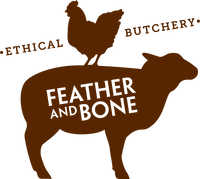The only heritage-breed turkeys available in Australia!
Try brining your turkey in our Love My Whey Bird Brine, stuffing it with our Christmas Bird Stuffing Kit and serving with our Davidson's Plum Bird Jus.
Pasture-raised, slow-growing, heritage turkeys are happiest, grow well and put on condition during the cooler months of the year. So Deutscher Heritage Turkeys are harvested in peak condition in winter and snap frozen for us to enjoy in summer.
All birds are thawed - please tell us if you want your turkey frozen.
Allow app 500 gm raw turkey per person when you're working out what size whole bird you'll need. See cooking tips below.
Why pasture-raised, heritage-breed turkeys?
Because they taste better and growing them outside on fresh pastures is more humane.
Unlike fast-growing, commercial turkey breeds that are grown either inside or on diminished land next to fixed sheds, heritage breed turkeys grow slowly and naturally and thrive ranging free outside, moving frequently to fresh pasture.
The benefits of slower maturation, a more free and active life and a complex diet that includes plenty of grasses and insects, results in a well proportioned bird with finely-textured, flavoursome meat and a higher fat content.
About Deutscher Heritage Turkeys
Turkey farmer, Daryl Deutscher, is an unsung hero of the Australian poultry industry. As well as being Australia's only heritage-breed turkey farmer, he's pioneered a unique turkey breed and is also one of only a handful of small farmers who are breeding, growing and slaughtering on farm. This is very unusual.
Read about Daryl and the farm.
Cooking tips
To brine or not to brine?
Our slow-growing, heritage turkeys can be successfully cooked without brining, so brining really is optional, but brining does lock in moisture and certainly will help to prevent the dreaded dry breast phenomenon. Also, our brine is very good!
The salt in the brine enters the cells via diffusion, the muscle fibres contract, retaining and drawing in moisture, increasing the weight of the bird by up to 10%. So, when the bird cooks and releases moisture, the end result will still be juicy.
If you do brine your bird, rinse and dry thoroughly before cooking.
Some parts of your bird will cook faster than others...
Follow these tips to avoid uneven cooking.
- Cook your turkey on a rack This allows the hot air to circulate around the bird and encourages more even cooking.
- Rub butter or similar all over your bird. This maintains moisture, distributes flavour and will also make the basting juices even more flavoursome. Seasoned butter works very well - lots of it, don't be shy
- Start hot, cook cooler. A slow-growing bird with firm flesh and strong skin needs a slower cook. For crispy skin and to seal the bird and lock in moisture, start cooking at 240C for the first 30 minutes then turn down to 175C for the main cooking.
- Baste, baste, baste. Every 30 minutes or so baste your bird all over with the juices collecting in the pan.
- It's cooked at 75C. When the internal temperature in the deepest part of the bird is 75C, you know it's ready. The simplest meat thermometer will do. Push the thermometer into the deepest part of the meat - either the breast or the thigh - and start checking after about 2.5 hours for a 6kg bird, less for smaller ones.
- Rest it for 20 minutes. Let the meat relax after cooking and you won't regret it. Cover the cooked turkey with foil and rest for 20 minutes before carving.
Turkey and stuffing photos by Alan Benson.












